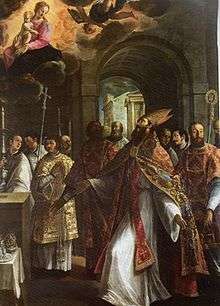Anselm of Lucca
| Anselm of Lucca | |
|---|---|
 | |
| Bishop, Confessor | |
| Born |
1036 Milan |
| Died | March 18, 1086 |
| Venerated in | Roman Catholic Church |
| Feast | March 18 |
| Patronage | Mantua |
Saint Anselm of Lucca (Latin: Anselmus; Italian: Anselmo; 1036 – March 18, 1086), born Anselm of Baggio (Anselmo da Baggio), was a medieval bishop of Lucca in Italy and a prominent figure in the Investiture Controversy amid the fighting in central Italy between Matilda, countess of Tuscany, and Emperor Henry IV. His uncle Anselm preceded him as bishop of Lucca before being elected to the papacy as Pope Alexander II; owing to this, he is sometimes distinguished as Anselm the Younger or Anselm II.
Life
Born in Milan, (Michael Ott says in Mantua.)[1] Anselm was a nephew of Anselm of Lucca the Elder, who became Pope Alexander II in 1061 and who designated Anselm to succeed him in his former position as Bishop of Lucca (1071) and sent him to Germany advising him to take investiture from Emperor Henry IV. Alexander II, Anselm's brother or uncle, may have elevated him to the cardinalate ca. 1062.[2]
Anselm went to Germany, but was loath to receive the insignia of spiritual power from a temporal ruler and returned without investiture. In 1073, Pope Gregory VII, again appointed Anselm Bishop of Lucca, but advised him not to accept investure from Henry IV. For some reason, Anselm did so this time, but soon felt such remorse that he resigned his bishopric, and entered the Benedictine Order at Padilirone, a Cluniac monastery near Mantua.[1]
Gregory VII ordered him to return to Lucca, and he reluctantly obeyed, but continued to lead the life of a monk. In the years 1077–79, he accepted the transfer of several castles from Countess Matilda, in preparation for Henry's expected campaign, which was carried out in 1081–84. Meanwhile, he attempted to impose stricter monastic discipline upon the canons of his cathedral. Most of the canons refused to submit to the new regulations. Anselm was expelled from Lucca in 1081, with the help of Emperor Henry and Guibert, Antipope Clement III, after the defeat of the papal defender, the Countess Matilda of Tuscany at the Battle of Volta Mantovana (October 1080). Anselm fled first to the shelter of Moriana, an episcopal stronghold only a few miles up the Arno from Lucca— accompanied by Bardo, a priest who later wrote his vita—then retired to Canossa as spiritual guide to Countess Matilda. Bishop Benzo of Alba, Henry IV's fiercely partisan supporter, tells how Matilda and Anselm stripped the monasteries to send gold and silver to Gregory in Rome .
Some time later Pope Victor III made him papal legate to Lombardy, with authorization to rule over all the dioceses which had been left without bishops due to the conflict between pope and emperor. His biographer Rangerius, who succeeded him as bishop of Lucca, ascribed to his prayers the rout of Matilda's forces and the other enemies of Gregory VII, which is why he is sometimes depicted in art as standing before an army in confusion.
Anselm was well versed in Scripture and wrote some important works attacking lay investiture and defending Pope Gregory against Antipope Guibert. He spent his last years assembling a collection of ecclesiastical law canons in 13 books, which formed the earliest of the collections of canons (Collectio canonum) supporting the Gregorian reforms, which afterwards were incorporated into the well-known Decretum of the jurist Gratian.
He died in Mantua on March 18, 1086, and is regarded as the patron saint of that city. A life of Anselm was written by his successor, Bishop Rangerius.
References
- 1 2 Ott, Michael. "St. Anselm of Lucca, the Younger." The Catholic Encyclopedia. Vol. 1. New York: Robert Appleton Company, 1907. 10 Mar. 2015
- ↑ This is according to Salvador Miranda. "The Cardinals of the Holy Roman Church: General list of Cardinals, 11th Century (999-1099)." Other sources consulted do not mention his promotion to the cardinalate. He is not listed among the cardinals of the 11th century in the modern printed prosopographies of the cardinals of that period (R. Hüls, Kardinäle, Klerus und Kirchen Roms: 1049-1130, Tübingen 1977; H.W. Klewitz, Reformpapsttum und Kardinalkolleg, Darmstadt 1957; K. Ganzer, Die entwicklung des auswärtigen Kardinalats im hohen Mittelater, Tübingen 1963)
External links
- Saint Anselm of Lucca the Younger
- Catholic Encyclopedia: St Anselm of Lucca, the Younger
- Projekt PseudoIsidor: Die Sammlung Anselms von Lucca (in German)
- Matilda of Tuscany: material concerning Anselm of Lucca
- ÖkumenischesHeiligenlexikon: Anselm II von Lucca (in German)
- Sant'Anselmo a Mantova (Italian)
Further reading
- Mitrofanov, Andrey (2015). L'ecclésiologie d'Anselme de Lucques (1036-1086) au service de Grégoire VII: Genèse, contenu et impact de sa "Collection canonique". Instrumenta Patristica et Mediaevalia 69. Turnhout: Brepols Publishers. (ISBN 978-2-503-55489-1)
- Cushing, Kathleen (1998). Papacy and Law in the Gregorian Revolution: The Canonistic Work of Anselm of Lucca. Oxford Historical Monographs. New York: Oxford University Press.